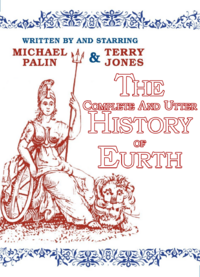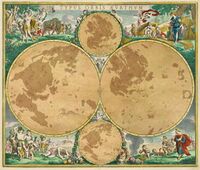Timeline of major events on Eurth
Introduction
"Sometimes the shadows of the past can be felt by the present."
Eurth is the homeworld of humanity, the only known intelligent life in the Universe. The earliest humanoids were the Europithecus afropensis. It appeared about two million years ago and, in several early migrations, it spread throughout southwestern Europa. This region includes such nations as Jilderen, Cabarria, Afropa, Bhalman and Dragonryders. It was likely the first human species to live in a hunter-gatherer society and to control fire. An adaptive and successful species, Europithecus afropensis persisted for more than a million years, and gradually diverged into new species by around 500.000 years ago, most notably Europithecus saharensis which adapted to live in a savannah-like climate of that time in Sa Hara. Civilisation is a cooperative product that all peoples have contributed to. It is our common legacy and debt.
Stone Age
The Stone Age is subdivided in three periods. The oldest period or Paleolithic includes early human history before 15.000 BCE. Early humans were mostly confined to cave dwellings. They made use of stone tools, with findings between circa 2,3-1,8 mya. It isn't until much later that fire is mastered between circa 700-120 kya. Even so, human culture on Eurth remained relatively primitive until the development of language around 100 kya. And the first clothing was created even later with evidence dated between 72K-42K.
During the last glacial maximum (50K), when the sea level was probably more than 110 meters lower than today, the first humans reached Marenesia and then Alharu. This ocean crossing is one of humanity’s important early achievements, even if it’s wrapped in mystery. Heading south form Jilderen, with assistance from ocean currents and prevailing winds, there exists an advantageous 'ocean highway' of island hopping.[1] Another, more controversial theory about the peopling of the 'new world' theories that humans could have migrated to Argis from northwestern Europa by boat along the drift ice of the North Adlantic Ocean. This theory is quite popular in Derthalen, but no serious scientists give this idea any credence.
The middle period or Mesolithic lasts from roughly 15.000 to 5.000 BCE. After the last Ice Age (11K), hunter-gatherers again spread north across the continent of Europa. This happened in multiple phases. We know this because of the pottery remains found in different styles. The beginning of the Holocene period (10K) is marked by the Neolithic Revolution and agriculture. Many farm animals were domesticated: pigs (11.000 BCE), sheep (11.000-9.000 BCE) and cattle (8.500 BCE). The same is true for the founder crops of agriculture (10.000-9.000 BCE) and rice (13.000-8.000 BCE). The human population of Azania and several other regions gradually began to adopt a more settled mode of living. This human activity has drastically changed the geography and biosphere of Eurth through urbanisation and deforestation. In ancient Memopotamia, the increased surpluses of food generated by agricultural production would soon lead to the blossoming of civilisation's first seeds.
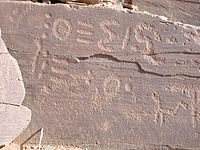
The newest period or Neolithic lasts from 5.000 until 2.000 BCE. Technological innovations help to improve transportation. Rowing oars come into use (4.500 BCE) and the wheel is invented (3.500 BCE). The domestication of the horse (3.200 BCE) and camels (3K BCE) further advance this. The earliest seaworthy boats are around 2.500 BCE, enabling the re-exploration of the Marenesian islands by early sailors occurs between 3.000-1.000 BCE. Around 3.000 BCE the first writing system is developed, greatly improving the way information is exchanged and preserved.
Bronze Age
The increasing food surplus allowed the maintenance of full-time specialised workers who were not engaged in agriculture, such as merchants, weavers, metallurgists and craftsmen. The taxation and redistribution of food supplies lead to the formation of governments. Around the 4th millennium BCE, the complexity of trade and administration outgrew human memory, and writing became a more dependable method of recording and presenting transactions in a permanent form. The invention of writing coincides in some areas with the early beginnings of the Bronze Age. Some of the earliest writings contain mentions of seven 'mother-peoples' on Eurth. These cradles of civilisation inhabit roughly the same time period and are distinguished by unique trade craft and pottery. This includes: the Tribes of Yuropa and Land of Shinar in Azania; the seafaring confederation of Mari Teutā (Proto-Europan: Sea People) on the islands; the Golden River civilisation and Houses of Amari in the Orient; the two remaining civilisations are unknown.
- Metallurgy
- Potter's wheel
- Copper and bronze tools
- City-states: urban centres surrounded by politically attached communities
- Ethnic gods, state religion
Iron Age

- Technology: iron tools
- Economy: includes trade and much specialization; often taxes
- Politics: city-states turn into small local Kingdoms
- Culture: one or more religions sanctioned by the state
Classical Age
The Classical Age lasts from approximately 1000 BCE to 500 CE.
1000-500 BCE
Smaller local kingdoms turn into regional Empires.
 Buran tribes extend from Magnaeus (south), over Akiiryu to Volsci, Karthenia and Nan Gorgwaith (northeast). (Anglo-Germano-Celto-Nordic)
Buran tribes extend from Magnaeus (south), over Akiiryu to Volsci, Karthenia and Nan Gorgwaith (northeast). (Anglo-Germano-Celto-Nordic) Steppe people between them, including Mongol-Swedes and Akiiryu.
Steppe people between them, including Mongol-Swedes and Akiiryu. Oriental nations on the eastern shores, from Jaihu to Koku to Ide Jima.
Oriental nations on the eastern shores, from Jaihu to Koku to Ide Jima.
 Island nations Miiros and Orioni develop on the fringes.
Island nations Miiros and Orioni develop on the fringes.
- 1004 BCE
 The Union of Clans is formed in Jilderen.
The Union of Clans is formed in Jilderen.
- 1000 BCE
- King Archaeminos founds the Archaeminoan dynasty in Azania. It becomes the largest empire of its age.
- 980 BCE
 Rebellious allied tribes in early Orioni appoint a Queen to better fight the Tigrai province of the Medani Empire.
Rebellious allied tribes in early Orioni appoint a Queen to better fight the Tigrai province of the Medani Empire.
- 900 BCE
 Proto-Aloorian culture in Europa starts as various smaller groups are forced towards the sea by larger clans and realms. The proto-Aloorians focus on seafaring and the sea in general, seeing it as a new opportunity and a way to get away from their enemies.
Proto-Aloorian culture in Europa starts as various smaller groups are forced towards the sea by larger clans and realms. The proto-Aloorians focus on seafaring and the sea in general, seeing it as a new opportunity and a way to get away from their enemies.
- 800-300 BCE
- The Axial age brings forth new ways of thinking regarding religion and philosophy, in a striking parallel development, without any obvious direct cultural contact between all of the participating cultures. Key thinkers from this age had a profound influence on future philosophies and religions.
- 800 BCE
 First evidence of a single proto-Aloorian language, further aiding trade and knowledge sharing between the various areas. Organised religion starts playing a role as a singular, unified language enabled sharing the oral traditions of the various groups.
First evidence of a single proto-Aloorian language, further aiding trade and knowledge sharing between the various areas. Organised religion starts playing a role as a singular, unified language enabled sharing the oral traditions of the various groups. Proto-Tapelt civilizations collapse due to changing climate on the Palu Peninsula.
Proto-Tapelt civilizations collapse due to changing climate on the Palu Peninsula.
- 753 BCE
 Ugeral the Savage proclaimed himself High King in Jilderen.
Ugeral the Savage proclaimed himself High King in Jilderen.
- 650-550 BCE
 Proto-Tapelt diverged into the Old Tapelt and Old Pekateka.
Proto-Tapelt diverged into the Old Tapelt and Old Pekateka.
- 536 BCE
 Erwanin queendom defeats the Medani Empire is defeated and becomes the first Orioni Empire.
Erwanin queendom defeats the Medani Empire is defeated and becomes the first Orioni Empire.
500-0 BCE
- 500 BCE
- The Hereskus Empire in Memopotamia gains independent from the Archaeminoan Empire.
 Some untold disaster forces proto-Aloorians groups to come together and merge, heavily increasing the population density and forcing creative solutions for homelessness among new inhabitants.
Some untold disaster forces proto-Aloorians groups to come together and merge, heavily increasing the population density and forcing creative solutions for homelessness among new inhabitants.
- 475 BCE
 Usage of derelict or otherwise unused ships as living space becomes common among proto-Aloorians. At first, these vessels are brought on land and used to build shelter; later on, shanty towns start to form on the water with large families inhabiting multiple boats.
Usage of derelict or otherwise unused ships as living space becomes common among proto-Aloorians. At first, these vessels are brought on land and used to build shelter; later on, shanty towns start to form on the water with large families inhabiting multiple boats.
- 437 BCE
 Vinmarian the Fair becomes ruler in Jilderen.
Vinmarian the Fair becomes ruler in Jilderen.
- 330 BCE
 In Occidental Europa, the boy-king Alexander of Adthens dreamed of conquering the known world. Starting in his home city of Adthens, he conquered the four known corners of the Occident. His death came prematurely.
In Occidental Europa, the boy-king Alexander of Adthens dreamed of conquering the known world. Starting in his home city of Adthens, he conquered the four known corners of the Occident. His death came prematurely.
- 150 BCE
 The Aroman Empire emerges in northwestern Europa. Built on top of the Alexandrian empire, they expand into a much larger territory by conquering central Europa.
The Aroman Empire emerges in northwestern Europa. Built on top of the Alexandrian empire, they expand into a much larger territory by conquering central Europa.
- 110 BCE
Humyara Kingdom established in Azania.
- 50 BCE
 Further expansion by foreign groups force the first groups of Aloorian travelers to exist. Generations of already living on ships aid those first groups with getting accustomed to the sea gypsy life.
Further expansion by foreign groups force the first groups of Aloorian travelers to exist. Generations of already living on ships aid those first groups with getting accustomed to the sea gypsy life.
0-500 CE
- 59 CE
 An Aroman merchant vessel, blown off its course, lands in Marenesia. Its wreck was found at the bottom of $Name Bay near Deopolis, Salvia.[2] Amphoras found in the ship are in fact similar in shape to jars produced in kilns at Tellakois, on the west coast of Adaptus.
An Aroman merchant vessel, blown off its course, lands in Marenesia. Its wreck was found at the bottom of $Name Bay near Deopolis, Salvia.[2] Amphoras found in the ship are in fact similar in shape to jars produced in kilns at Tellakois, on the west coast of Adaptus.
- 100 CE
 Proto-Aslo migration and invasion of the Palu Peninsula.
Proto-Aslo migration and invasion of the Palu Peninsula.
- 200 CE
 The Aroman Empire becomes too large to be governed from a single location. It is split into two self-governing halves. Internal mismanagement and external threats cause the Empire to collapse. Its core remains continued as Tagmatium and Adaptus. The Aroman influences can still be felt by the language ties extending as far south as the Byzantine Sea, from Byzantium Nova (west) to Pirilao (east).
The Aroman Empire becomes too large to be governed from a single location. It is split into two self-governing halves. Internal mismanagement and external threats cause the Empire to collapse. Its core remains continued as Tagmatium and Adaptus. The Aroman influences can still be felt by the language ties extending as far south as the Byzantine Sea, from Byzantium Nova (west) to Pirilao (east).
- 220 CE
 The Volsci and other coastal Buran sailors take advantage of the West-Aroman collapse to resume piracy on the Kosscow Sea and other nearby waters.
The Volsci and other coastal Buran sailors take advantage of the West-Aroman collapse to resume piracy on the Kosscow Sea and other nearby waters.
- 420 CE
 Colonists from the country of Atmora make their way into the Auraid Bay, successfully colonizing and founding Gut Atmora, under the rule of the Atmoran High King, Totgald.
Colonists from the country of Atmora make their way into the Auraid Bay, successfully colonizing and founding Gut Atmora, under the rule of the Atmoran High King, Totgald.
- 450 CE
 No sedentary groups remain, all Aloorians live on naval vessels for, at the least, the majority of the year. Due to the large size of the Europan waterways, the Aloorians slowly separate between Northern and Southern groups; each known for their own specialty, customs and ship types. Many of the various coastal regimes in Europa hire Aloorian vessels and groups for one reason or another at some point in time.
No sedentary groups remain, all Aloorians live on naval vessels for, at the least, the majority of the year. Due to the large size of the Europan waterways, the Aloorians slowly separate between Northern and Southern groups; each known for their own specialty, customs and ship types. Many of the various coastal regimes in Europa hire Aloorian vessels and groups for one reason or another at some point in time. Proto-Aslo dominance of the Palu Peninsula at it's greatest extent.
Proto-Aslo dominance of the Palu Peninsula at it's greatest extent.
Post-Classical Era
6th century
- 500
 Late Aroman Empire persists in Byzantium Nova
Late Aroman Empire persists in Byzantium Nova
- 520s
Humyara Kingdom in Azania loses its independence, becoming a tributary state of Qubdi.
- 555
 The First Plague appears in Youtabonia. Rages across the continent of Europa, and persists in small pockets until the circa 700.
The First Plague appears in Youtabonia. Rages across the continent of Europa, and persists in small pockets until the circa 700.
- 575
 Salamic Golden Age in Hakenium and Sa Hara. It lasts nearly five centuries until approximately 1250.
Salamic Golden Age in Hakenium and Sa Hara. It lasts nearly five centuries until approximately 1250.
7th century
- 665
 For unknown reasons, anger grows in Gut Atmora and a war for independence from their home country of Atmora strikes. Atmora gains the upper hand for the first half of the war until the Atmoran general Ysgramor and his five sons joined the side of the rebels. Raising an army of 500 men and women known as the Zeymahzin, he drove back the Atmoran forces despite being outnumbered using his tactical knowhow. By the end of the war, he valiantly proclaimed independence and his new rule over the lands of Vataanjunaar.
For unknown reasons, anger grows in Gut Atmora and a war for independence from their home country of Atmora strikes. Atmora gains the upper hand for the first half of the war until the Atmoran general Ysgramor and his five sons joined the side of the rebels. Raising an army of 500 men and women known as the Zeymahzin, he drove back the Atmoran forces despite being outnumbered using his tactical knowhow. By the end of the war, he valiantly proclaimed independence and his new rule over the lands of Vataanjunaar.
8th century
- 700
 In Byzantium Nova the Codex Aromanum is compiled, the earliest surviving complete manuscript from the Aroman Empire.
In Byzantium Nova the Codex Aromanum is compiled, the earliest surviving complete manuscript from the Aroman Empire.
- 731
 First incidence of plague in Orioni in the colonial city of Ishikamo.
First incidence of plague in Orioni in the colonial city of Ishikamo.
9th century
- 800
The Sacred Aroman Realm (Regnum Sanctum Arhomanus Orientalis) is formed, an independent continuation of the old Aroman Empire, containing the present-day nations of: Byzantium Nova, Lysian Republic, Cristina, Mantella, Emakera, Pirilao, Montgisard, Red Iberic Workers, Rennd, The Cathunters, Novanya.
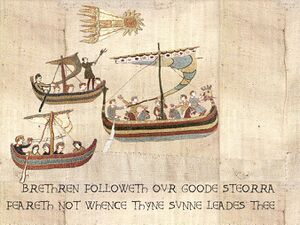
- 887
- Olrik Naddoddson is banished from Delmark "because of some killings". He and his family lead a Buranian exploration into the Adlantic Ocean.
10th century
- 900-1400
- The Little Ice Age disrupts climate patterns and farming harvests. This leads to increased conflict, human migration, spread of disease. Certainly not a good time to be alive.
- 987
 The first plague reaches Orioni mainland via Vega in October 987.
The first plague reaches Orioni mainland via Vega in October 987.
11th century
- 1050
- The Little Ice Age causes the Adlantic Ocean's pack ice to grow.
12th century
- 1102-1119
 Rihannsu westward migration from the Central Europan Steppes, move into Tagmatine Empire.
Rihannsu westward migration from the Central Europan Steppes, move into Tagmatine Empire.
- 1120
 Rihannsu formally become federates of Tagmatine Empire.
Rihannsu formally become federates of Tagmatine Empire.
- 1172
 City of Saint Christ becomes part of the Eternal Empire of Hémus.[3]
City of Saint Christ becomes part of the Eternal Empire of Hémus.[3]
13th century
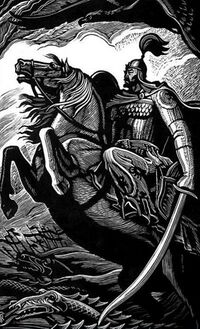
- 1202
 Rihannsu forced to depart the Tagmatine Empire.
Rihannsu forced to depart the Tagmatine Empire.
- 1205
Babluqiya Sultanate subjugates Qubdi.
- 1208
 Rihannsu make landfall on the continent of Aurelia, establish city-states, including the first city, Dartha.
Rihannsu make landfall on the continent of Aurelia, establish city-states, including the first city, Dartha.
- 1250
Invasion of Buran from the Central Europan Steppes.
- 1270
 Formation of the Crescent Empire.
Formation of the Crescent Empire.
- 1277
Buranian expansion halted after the Battle of Montgisard.
- 1293-1343
 The Rihannsu Clan Wars erupt between the various city-states, resulting in the deaths of tens of thousands.
The Rihannsu Clan Wars erupt between the various city-states, resulting in the deaths of tens of thousands.
14th century
- 1300
- Pseudo-Ottoman Empire is formed and lasts until the early 1900s.
- 1315
- The Great Famine lasts until 1317.
- 1340
- The Black Death strikes again, this timing lasting until circa 1400.
![]() 1343: The Rihan Republic is formally established after fifty years of warfare between the various clan-led cities.
1343: The Rihan Republic is formally established after fifty years of warfare between the various clan-led cities.
15th century
- 1480
 Crescent Empire expands out of the Palu Peninsula as a hegemonic empire.
Crescent Empire expands out of the Palu Peninsula as a hegemonic empire.
Modern Age
Early Modern Age
This age lasts approximately from 1500-1800.
- 1300-1600
- The Elevation is a great period of rebirth of classical-based art and learning that began in the 14th Century. From the Old Arhoman elevationam (nominative elevatio) meaning "a lifting up," noun of action from past participle stem of elevare.
- 1400-1700
- The Age of Reconnection is a broad designation for a period of increased overseas exploration. It's marked by emerging globalisation. Many lands previously forgotten during the Post-Classical Age were re-discovered. Since the majority of these lands were already populated, explorers were often seen as invaders.
- 1522
 The War of the Two kingdoms in PyeMcGowan comes to an end.
The War of the Two kingdoms in PyeMcGowan comes to an end.
- 1540
 The island of Seylos is settled by the exiled King Harold and his supporters.
The island of Seylos is settled by the exiled King Harold and his supporters.
- 1593-1606
 Thirteen Years' War was an indecisive land war between the Memopotamian sultanates and the Orioni Empire.
Thirteen Years' War was an indecisive land war between the Memopotamian sultanates and the Orioni Empire.
Late Modern Age
This age lasts approximately from 1750-1900. Marked by strong political and industrial revolutions.
- 1750-1850
- Political Revolutions
- 1760-1830
- First industrial revolution including textile, steam, iron, mining, gas
- 1775-1825
- The first explorers set out to find Terra Congruentia Incognita, a large landmass theorised by classical mathematician Metagoras of Arhomaneia (550–480 BCE), located past the southern Antargic Circle.
- 1807-1832


 Eustacian Wars involving the Rihan Republic, Kirvina, Shffahkia.
Eustacian Wars involving the Rihan Republic, Kirvina, Shffahkia.
- 1811
 Nicolas Panoleon rises to prominence during the Lysian Revolution of 1799 and leads several successful campaigns against the Sacred Aroman Realm. He reigned as Emperor Nicolas I from 1811 until 1818.
Nicolas Panoleon rises to prominence during the Lysian Revolution of 1799 and leads several successful campaigns against the Sacred Aroman Realm. He reigned as Emperor Nicolas I from 1811 until 1818.
- 1816
- Great Famine kills 650.000 people. The massive eruption of Mount Synturia dispersed ash around the world, significantly lowering temperatures, leading to failed harvests.
- 1850-1900
- Second industrial revolution including steel, chemical, automobile, petroleum, rubber
- 1853
 Limonaian conquest of the Crescent Empire. Subsequent establishment of the Colony of Metztlitlalio.
Limonaian conquest of the Crescent Empire. Subsequent establishment of the Colony of Metztlitlalio.
- 1859
- Biologist Stephen Erwin publishes his theory of evolution in About the Provenance of Living Organisms. The inspiration for this theory came from his earler expedition to Oyus on the HMS Foxhound.
- 1866
- Mark Karls is exiled from Variota. He takes refuge in Fulgistan, where he publishes his Plebeian Manifesto and calls for a global revolution. The first Transnational Plebiscite is organised in Batengdei.
![]() 1867-1883: Wars of Liberation in Girkmand
1867-1883: Wars of Liberation in Girkmand
20th Century
Transition from a world of empire to a global international system organised around the sovereign state.
- 1910
- Economic crisis
- 1915
 Byzantine Flu
Byzantine Flu
- 1927
- Economic crisis
- 1932-1956
 The Long War or 'War of Imperialist Aggression'.
The Long War or 'War of Imperialist Aggression'.
- 1940-1975
- Eumanity enters the Atomic Age
- 1941-1947



 Thalassan War, involving Andalla, Sunset Sea Islands, Giokto, and Kipan
Thalassan War, involving Andalla, Sunset Sea Islands, Giokto, and Kipan
- 1943
- Economic crisis
- 1945-1959
 Temporary independence of Metztlitlalio as the Unified Republic of Palu then the South Palu Confederation.
Temporary independence of Metztlitlalio as the Unified Republic of Palu then the South Palu Confederation.
- 1947-1979
- Decolonisation. The imperial powers gave up most of their overseas territories, often because they were forced to do so by popular movements or wars of national liberation.
- 1949
- First Argic War
- 1950
- Eumanity enters the Jet Age
- 1955
- Eumanity enters the Space Age
- 1958
- Economic crisis
 Law of the Seas convention is signed in Sunset Sea Islands
Law of the Seas convention is signed in Sunset Sea Islands
- 1959-1974
 Selayari Civil War
Selayari Civil War
- 1964
- Sevrunian rebellion[4]
- 1965
- Oil Producing Eurthican Countries (an organization) is formed.
- 1968-1974

 Second Argic War involving Iverica, Prymont, Ostport, Hellenic Rus and Germanic Staat.
Second Argic War involving Iverica, Prymont, Ostport, Hellenic Rus and Germanic Staat.
- 1972-1975
- Great Alharun War, also known as the War of the Limonaian Restoration.
- 1974
- Economic crisis
- 1975
- Eumanity experiences a Digital Revolution
- 1977
 Independence of the Archpriest Dominion of Metztlitlalio
Independence of the Archpriest Dominion of Metztlitlalio
- 1979
 Unification of Prymont
Unification of Prymont
- 1991

 Marenesian Wars
Marenesian Wars
- Economic crisis
- 1993-1995
- Qothwane Crisis begins, ending with the joint invasion of Qothwane Confederation
- 1995
- Eumanity enters the Information Age
21st Century
- 2003
 Cicada collective relases secret documents obtained through computer hacking and cyber attacks against several governments, institutions and corporations.
Cicada collective relases secret documents obtained through computer hacking and cyber attacks against several governments, institutions and corporations.
- 2006
 Tarragat Island War[5]
Tarragat Island War[5]
- 2009
 End of the Metztlitlalio civil war. Agilnaj dissolved.
End of the Metztlitlalio civil war. Agilnaj dissolved.
 First war between the Rihan Republic and Enolia, results in a bloody stalemate.
First war between the Rihan Republic and Enolia, results in a bloody stalemate.
- 2018-2019
 The island nation of Eire experiences the loss of its duke. The resulting succession ends with its integration into The Kingdom of Seylos.
The island nation of Eire experiences the loss of its duke. The resulting succession ends with its integration into The Kingdom of Seylos.
- 2019
 Second war between the Rihan Republic and Enolia, results in Rihannsu annexation of Enolia.
Second war between the Rihan Republic and Enolia, results in Rihannsu annexation of Enolia.
- 2019


 Establishment of the League of Alharu and Aurelian Native Nations.
Establishment of the League of Alharu and Aurelian Native Nations.
- 2020
 The island of Ceris to the west of Seylos, experiences a major economic and societal collapse. Seylos and several other nations attempt to intercede to stabilize the island whilst also planning to grab influence and power in the process.
The island of Ceris to the west of Seylos, experiences a major economic and societal collapse. Seylos and several other nations attempt to intercede to stabilize the island whilst also planning to grab influence and power in the process.
Start of the Oil Wars.
References
- ↑ So who discovered Argis, Alharu and Aurelia? by Orioni (22 May 2018)
- ↑ Walter Sullivan, Rio artifacts may indicate Roman visit, The New York Times, 10 October 1982
- ↑ Brief history of Cristina (13 August 2017)
- ↑ The Sevrunian Rebellion (7 July 2005)
- ↑ Tarragat Island War(August 2006)
